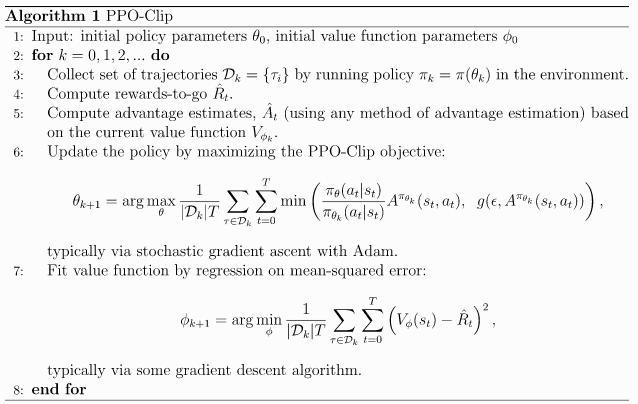Proximal 정책 최적화
- 원본 링크 : https://keras.io/examples/rl/ppo_cartpole/
- 최종 확인 : 2024-11-23
저자 : Ilias Chrysovergis
생성일 : 2021/06/24
최종 편집일 : 2024/03/12
설명 : Implementation of a Proximal Policy Optimization agent for the CartPole-v1 environment.
Introduction
This code example solves the CartPole-v1 environment using a Proximal Policy Optimization (PPO) agent.
CartPole-v1
A pole is attached by an un-actuated joint to a cart, which moves along a frictionless track. The system is controlled by applying a force of +1 or -1 to the cart. The pendulum starts upright, and the goal is to prevent it from falling over. A reward of +1 is provided for every timestep that the pole remains upright. The episode ends when the pole is more than 15 degrees from vertical, or the cart moves more than 2.4 units from the center. After 200 steps the episode ends. Thus, the highest return we can get is equal to 200.
Proximal Policy Optimization
PPO is a policy gradient method and can be used for environments with either discrete or continuous action spaces. It trains a stochastic policy in an on-policy way. Also, it utilizes the actor critic method. The actor maps the observation to an action and the critic gives an expectation of the rewards of the agent for the observation given. Firstly, it collects a set of trajectories for each epoch by sampling from the latest version of the stochastic policy. Then, the rewards-to-go and the advantage estimates are computed in order to update the policy and fit the value function. The policy is updated via a stochastic gradient ascent optimizer, while the value function is fitted via some gradient descent algorithm. This procedure is applied for many epochs until the environment is solved.

Note
This code example uses Keras and Tensorflow v2. It is based on the PPO Original Paper, the OpenAI’s Spinning Up docs for PPO, and the OpenAI’s Spinning Up implementation of PPO using Tensorflow v1.
OpenAI Spinning Up Github - PPO
Libraries
For this example the following libraries are used:
numpyfor n-dimensional arraystensorflowandkerasfor building the deep RL PPO agentgymnasiumfor getting everything we need about the environmentscipy.signalfor calculating the discounted cumulative sums of vectors
import os
os.environ["KERAS_BACKEND"] = "tensorflow"
import keras
from keras import layers
import numpy as np
import tensorflow as tf
import gymnasium as gym
import scipy.signalFunctions and class
def discounted_cumulative_sums(x, discount):
# Discounted cumulative sums of vectors for computing rewards-to-go and advantage estimates
return scipy.signal.lfilter([1], [1, float(-discount)], x[::-1], axis=0)[::-1]
class Buffer:
# Buffer for storing trajectories
def __init__(self, observation_dimensions, size, gamma=0.99, lam=0.95):
# Buffer initialization
self.observation_buffer = np.zeros(
(size, observation_dimensions), dtype=np.float32
)
self.action_buffer = np.zeros(size, dtype=np.int32)
self.advantage_buffer = np.zeros(size, dtype=np.float32)
self.reward_buffer = np.zeros(size, dtype=np.float32)
self.return_buffer = np.zeros(size, dtype=np.float32)
self.value_buffer = np.zeros(size, dtype=np.float32)
self.logprobability_buffer = np.zeros(size, dtype=np.float32)
self.gamma, self.lam = gamma, lam
self.pointer, self.trajectory_start_index = 0, 0
def store(self, observation, action, reward, value, logprobability):
# Append one step of agent-environment interaction
self.observation_buffer[self.pointer] = observation
self.action_buffer[self.pointer] = action
self.reward_buffer[self.pointer] = reward
self.value_buffer[self.pointer] = value
self.logprobability_buffer[self.pointer] = logprobability
self.pointer += 1
def finish_trajectory(self, last_value=0):
# Finish the trajectory by computing advantage estimates and rewards-to-go
path_slice = slice(self.trajectory_start_index, self.pointer)
rewards = np.append(self.reward_buffer[path_slice], last_value)
values = np.append(self.value_buffer[path_slice], last_value)
deltas = rewards[:-1] + self.gamma * values[1:] - values[:-1]
self.advantage_buffer[path_slice] = discounted_cumulative_sums(
deltas, self.gamma * self.lam
)
self.return_buffer[path_slice] = discounted_cumulative_sums(
rewards, self.gamma
)[:-1]
self.trajectory_start_index = self.pointer
def get(self):
# Get all data of the buffer and normalize the advantages
self.pointer, self.trajectory_start_index = 0, 0
advantage_mean, advantage_std = (
np.mean(self.advantage_buffer),
np.std(self.advantage_buffer),
)
self.advantage_buffer = (self.advantage_buffer - advantage_mean) / advantage_std
return (
self.observation_buffer,
self.action_buffer,
self.advantage_buffer,
self.return_buffer,
self.logprobability_buffer,
)
def mlp(x, sizes, activation=keras.activations.tanh, output_activation=None):
# Build a feedforward neural network
for size in sizes[:-1]:
x = layers.Dense(units=size, activation=activation)(x)
return layers.Dense(units=sizes[-1], activation=output_activation)(x)
def logprobabilities(logits, a):
# Compute the log-probabilities of taking actions a by using the logits (i.e. the output of the actor)
logprobabilities_all = keras.ops.log_softmax(logits)
logprobability = keras.ops.sum(
keras.ops.one_hot(a, num_actions) * logprobabilities_all, axis=1
)
return logprobability
seed_generator = keras.random.SeedGenerator(1337)
# Sample action from actor
@tf.function
def sample_action(observation):
logits = actor(observation)
action = keras.ops.squeeze(
keras.random.categorical(logits, 1, seed=seed_generator), axis=1
)
return logits, action
# Train the policy by maxizing the PPO-Clip objective
@tf.function
def train_policy(
observation_buffer, action_buffer, logprobability_buffer, advantage_buffer
):
with tf.GradientTape() as tape: # Record operations for automatic differentiation.
ratio = keras.ops.exp(
logprobabilities(actor(observation_buffer), action_buffer)
- logprobability_buffer
)
min_advantage = keras.ops.where(
advantage_buffer > 0,
(1 + clip_ratio) * advantage_buffer,
(1 - clip_ratio) * advantage_buffer,
)
policy_loss = -keras.ops.mean(
keras.ops.minimum(ratio * advantage_buffer, min_advantage)
)
policy_grads = tape.gradient(policy_loss, actor.trainable_variables)
policy_optimizer.apply_gradients(zip(policy_grads, actor.trainable_variables))
kl = keras.ops.mean(
logprobability_buffer
- logprobabilities(actor(observation_buffer), action_buffer)
)
kl = keras.ops.sum(kl)
return kl
# Train the value function by regression on mean-squared error
@tf.function
def train_value_function(observation_buffer, return_buffer):
with tf.GradientTape() as tape: # Record operations for automatic differentiation.
value_loss = keras.ops.mean((return_buffer - critic(observation_buffer)) ** 2)
value_grads = tape.gradient(value_loss, critic.trainable_variables)
value_optimizer.apply_gradients(zip(value_grads, critic.trainable_variables))Hyperparameters
# Hyperparameters of the PPO algorithm
steps_per_epoch = 4000
epochs = 30
gamma = 0.99
clip_ratio = 0.2
policy_learning_rate = 3e-4
value_function_learning_rate = 1e-3
train_policy_iterations = 80
train_value_iterations = 80
lam = 0.97
target_kl = 0.01
hidden_sizes = (64, 64)
# True if you want to render the environment
render = FalseInitializations
# Initialize the environment and get the dimensionality of the
# observation space and the number of possible actions
env = gym.make("CartPole-v1")
observation_dimensions = env.observation_space.shape[0]
num_actions = env.action_space.n
# Initialize the buffer
buffer = Buffer(observation_dimensions, steps_per_epoch)
# Initialize the actor and the critic as keras models
observation_input = keras.Input(shape=(observation_dimensions,), dtype="float32")
logits = mlp(observation_input, list(hidden_sizes) + [num_actions])
actor = keras.Model(inputs=observation_input, outputs=logits)
value = keras.ops.squeeze(mlp(observation_input, list(hidden_sizes) + [1]), axis=1)
critic = keras.Model(inputs=observation_input, outputs=value)
# Initialize the policy and the value function optimizers
policy_optimizer = keras.optimizers.Adam(learning_rate=policy_learning_rate)
value_optimizer = keras.optimizers.Adam(learning_rate=value_function_learning_rate)
# Initialize the observation, episode return and episode length
observation, _ = env.reset()
episode_return, episode_length = 0, 0Train
# Iterate over the number of epochs
for epoch in range(epochs):
# Initialize the sum of the returns, lengths and number of episodes for each epoch
sum_return = 0
sum_length = 0
num_episodes = 0
# Iterate over the steps of each epoch
for t in range(steps_per_epoch):
if render:
env.render()
# Get the logits, action, and take one step in the environment
observation = observation.reshape(1, -1)
logits, action = sample_action(observation)
observation_new, reward, done, _, _ = env.step(action[0].numpy())
episode_return += reward
episode_length += 1
# Get the value and log-probability of the action
value_t = critic(observation)
logprobability_t = logprobabilities(logits, action)
# Store obs, act, rew, v_t, logp_pi_t
buffer.store(observation, action, reward, value_t, logprobability_t)
# Update the observation
observation = observation_new
# Finish trajectory if reached to a terminal state
terminal = done
if terminal or (t == steps_per_epoch - 1):
last_value = 0 if done else critic(observation.reshape(1, -1))
buffer.finish_trajectory(last_value)
sum_return += episode_return
sum_length += episode_length
num_episodes += 1
observation, _ = env.reset()
episode_return, episode_length = 0, 0
# Get values from the buffer
(
observation_buffer,
action_buffer,
advantage_buffer,
return_buffer,
logprobability_buffer,
) = buffer.get()
# Update the policy and implement early stopping using KL divergence
for _ in range(train_policy_iterations):
kl = train_policy(
observation_buffer, action_buffer, logprobability_buffer, advantage_buffer
)
if kl > 1.5 * target_kl:
# Early Stopping
break
# Update the value function
for _ in range(train_value_iterations):
train_value_function(observation_buffer, return_buffer)
# Print mean return and length for each epoch
print(
f" Epoch: {epoch + 1}. Mean Return: {sum_return / num_episodes}. Mean Length: {sum_length / num_episodes}"
)결과
Epoch: 1. Mean Return: 20.512820512820515. Mean Length: 20.512820512820515
Epoch: 2. Mean Return: 24.84472049689441. Mean Length: 24.84472049689441
Epoch: 3. Mean Return: 33.333333333333336. Mean Length: 33.333333333333336
Epoch: 4. Mean Return: 38.46153846153846. Mean Length: 38.46153846153846
Epoch: 5. Mean Return: 59.701492537313435. Mean Length: 59.701492537313435
Epoch: 6. Mean Return: 80.0. Mean Length: 80.0
Epoch: 7. Mean Return: 111.11111111111111. Mean Length: 111.11111111111111
Epoch: 8. Mean Return: 200.0. Mean Length: 200.0
Epoch: 9. Mean Return: 266.6666666666667. Mean Length: 266.6666666666667
Epoch: 10. Mean Return: 444.44444444444446. Mean Length: 444.44444444444446
Epoch: 11. Mean Return: 400.0. Mean Length: 400.0
Epoch: 12. Mean Return: 1000.0. Mean Length: 1000.0
Epoch: 13. Mean Return: 2000.0. Mean Length: 2000.0
Epoch: 14. Mean Return: 444.44444444444446. Mean Length: 444.44444444444446
Epoch: 15. Mean Return: 2000.0. Mean Length: 2000.0
Epoch: 16. Mean Return: 4000.0. Mean Length: 4000.0
Epoch: 17. Mean Return: 2000.0. Mean Length: 2000.0
Epoch: 18. Mean Return: 4000.0. Mean Length: 4000.0
Epoch: 19. Mean Return: 4000.0. Mean Length: 4000.0
Epoch: 20. Mean Return: 2000.0. Mean Length: 2000.0
Epoch: 21. Mean Return: 2000.0. Mean Length: 2000.0
Epoch: 22. Mean Return: 4000.0. Mean Length: 4000.0
Epoch: 23. Mean Return: 4000.0. Mean Length: 4000.0
Epoch: 24. Mean Return: 4000.0. Mean Length: 4000.0
Epoch: 25. Mean Return: 4000.0. Mean Length: 4000.0
Epoch: 26. Mean Return: 4000.0. Mean Length: 4000.0
Epoch: 27. Mean Return: 4000.0. Mean Length: 4000.0
Epoch: 28. Mean Return: 4000.0. Mean Length: 4000.0
Epoch: 29. Mean Return: 4000.0. Mean Length: 4000.0
Epoch: 30. Mean Return: 4000.0. Mean Length: 4000.0Visualizations
Before training:

After 8 epochs of training:

After 20 epochs of training:
